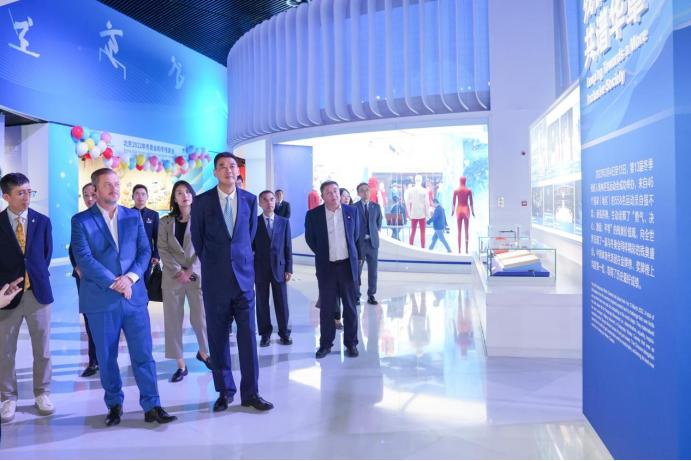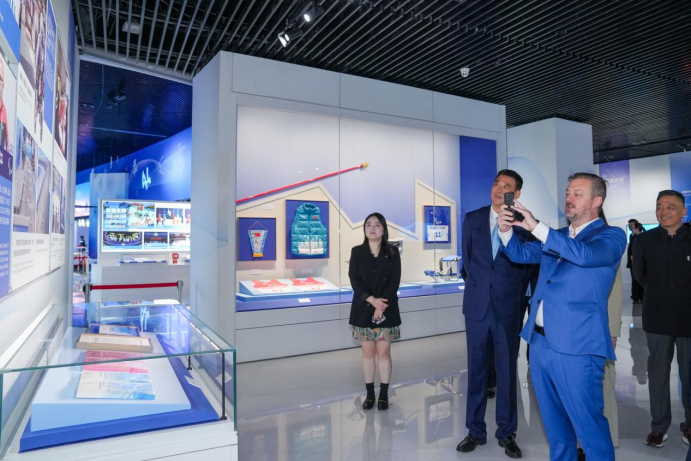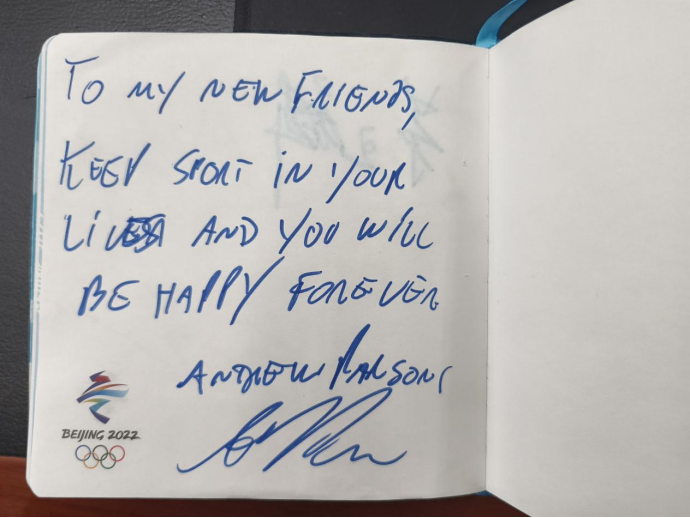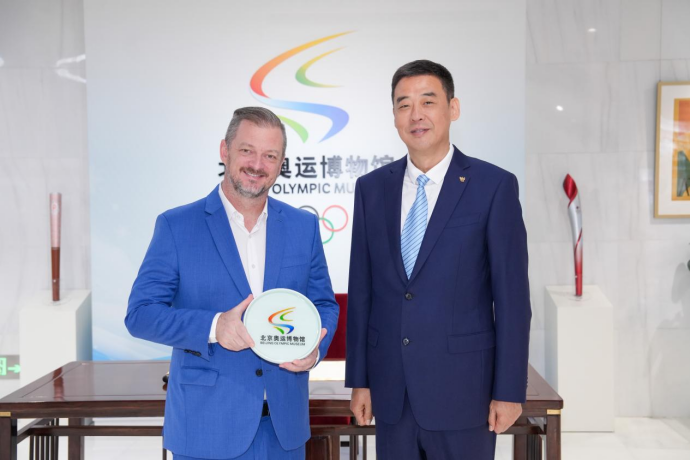On the morning of 24 April, the Beijing Olympic Museum received the visiting delegation from the International Paralympic Committee (IPC) led by its President Andrew Parsons. Fu Xiaohui, Vice President and Secretary-General of the Beijing Olympic City Development Association (BODA) and Director-General of the Beijing Olympic City Development Centre, Yong Zhijun, Deputy Director of the Sports Department of the China Disabled Persons’ Federation (CDPF) and Gao Yunchao, Deputy Secretary-General of BODA and Deputy Director-General of the Beijing Olympic City Development Centre, accompanied the IPC President during his visit.


(Fu Xiaohui accompanies Andrew Parsons on the visit)
Into the themed entrance hall, Andrew Parsons marvelled at how grand and imposing the museum is, as Hou Ming, the museum’s director, gave an introduction.
In front of the architectural model of the three competition zones, the IPC President recalled the remarkable moments at the Beijing 2022 Paralympic Winter Games.
In the torch display area, he took a close look at the ten shortlisted torches for the Beijing 2022 Games, saying that the torches were all exquisite and eye-opening and it was fun to learn about how the torches were produced.

(Andrew Parsons in front of the shortlisted torches)
In the zone dedicated to international exchanges, Andrew Parsons was delighted to see his photos taken during the preparations for the Beijing 2022 Paralympic Winter Games, reminiscing about some details at the time.
When viewing a replica of athletes’ apartments in Beijing Olympic Village and Paralympic Village, the president noted that he had not experienced all the functions of the smart bed and looked forward to having an opportunity to try it out again.
In the Home of Volunteers display area, President Parsons spoke highly of the volunteer work of Beijing 2022 Paralympic Winter Games.
In front of the Paralympic ice hockey display case, the IPC President recognized Chinese Paralympic ice hockey team captain Cui Yutao and team member Shen Yifeng, saying that he was and expressed his interest in about the development of Paralympic ice hockey in China.
When seeing a photo of Craig Spence, IPC’s chief brand and communications officer, in the accessibility zone, the IPC President cheerfully took out his phone to take photos, saying that he would share with his colleagues the pride and joy of being featured in the collection of the Beijing Olympic Museum.

(Andrew Parsons takes photos)
Then, Andrew Parsons stopped to watch a video about the closing ceremony of the Beijing 2022 Paralympic Winter Games. He recalled the performances and his remarks delivered at the closing ceremony, in which he stated, “You delivered stunning, secure and spectacular… For sure, China has set a benchmark for all future winter Games.”
In the exhibition area dedicated to the Beijing 2008 Summer Paralympics, Andrew Parsons recognized the mascot and blurted out in Chinese, “Fu Niu Lele!” Seeing the lofty sailing collection, he immediately pointed out that it was a competition boat during the sailing competition in Qingdao.
In the educational activity area, a group of students from Dianchanglu Primary School of Shijingshan District were making flowers using a traditional Shanghai wool-knitting technique called Haipai (literally “Shanghai style”), under the instruction of the teacher from the Beijing Demonstration Center of Service for Persons with Disabilities. This technique was used to make bouquets awarded to winners at the Beijing 2022 Games. Andrew Parsons was delighted to see that this Olympic legacy was carried on in educational activities after the Games. He was given a knitted sunflower, a symbol of warmth and positivity, by two students as a gift, and happily wrote on the children’s notebook, “To my new friends, keep sport in your lives and you will be happy forever.” Then, the president took a group photo with the students and wished them to grow stronger in sport and life.

(A message left by Andrew Parsons on the notebook)

(A group photo of Andrew Parsons and the children)
After the visit, Andrew Parsons was presented a cloisonné enamel plate bearing the logo of the Beijing Olympic Museum by Fu Xiaohui.

(Andrew Parsons holds the gift from Fu Xiaohui)
The IPC President left a message in the guestbook, reading “Incredible Games! Incredible memories! Incredible museum!”

(Andrew Parsons leaves a message in the guestbook)
He also autographed the official poster of the Beijing 2008 Summer Paralympics, the mascot poster and torch of the Beijing 2022 Paralympic Winter Games and the invitation to the opening ceremony of the Beijing 2022 Paralympic Winter Games.
After that, Fu Xiaohui and Andrew Parsons held a talk. Fu gave an overview of the development of sports for people with disabilities and the construction of barrier-free environments in Beijing after 2022, and introduced the mission of BODA and the work it has done in recent years, especially the efforts in supporting disability sports and the Paralympics through flagship events such as the Beijing Olympic City Sports Culture Festival, as well as the cooperation with international sports organisations including the IOC and the IPC. He said that with the Milano Cortina 2026 Paralympic Winter Games approaching, BODA is willing to strengthen exchanges and cooperation with the IPC and looks forward to continued support from the IPC.
Noting the important role of BODA in carrying on the Olympic legacy, Andrew Parsons stated that the Beijing Olympic Museum not only makes the savouring memories and past glories last, but also constantly reminds the public why Beijing hosted the Olympic and Paralympic Games. He hopes that other Olympic cities could follow in the footsteps of Beijing to set up Olympic legacy agencies like BODA and that Beijing could stage major sporting events like the Summer Olympics and Winter Olympics again in the future. He voiced strong support for a cooperative relationship between the two sides on the Milano Cortina 2026 Paralympic Winter Games and would designate staff members for liaison with BODA to facilitate cooperation in event organisation, legacy use and other areas and provide necessary support and assistance.
The Beijing Olympic Museum is a permanent Olympic themed museum that gathers, preserves and presents the history of the two Olympic Games staged in Beijing and performs multiple functions such as Olympic collection research, conservation, exhibition and education. With a floor space of about 47,000 square metres, the museum consists of the indoor and outdoor sections. First established in 2009, the museum reopened to the public in February 2024 after renovation. Over the last year, it has received a total of 1.37 million visits, including about 390,000 visits from minors and 100,000 visits from international tourists.
Also present at the visit were staff members from the China Disabled Persons’ Federation, the Beijing Olympic City Development Centre and the Beijing Olympic Museum.

© Copyright 2020. All rights reserved
Beijing Olympic City Development Association.All rights reserved.Beijing ICP 11016671 No.